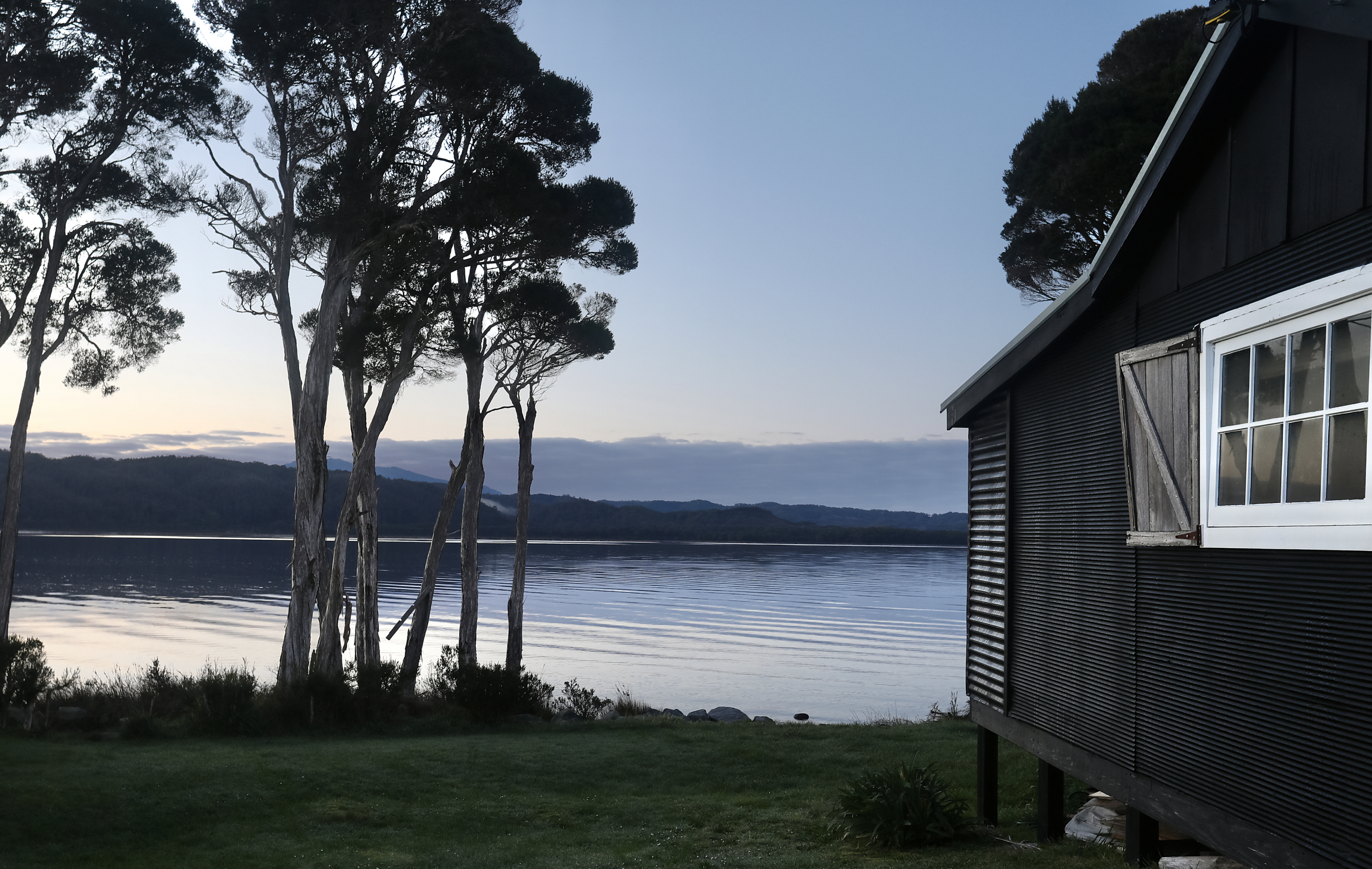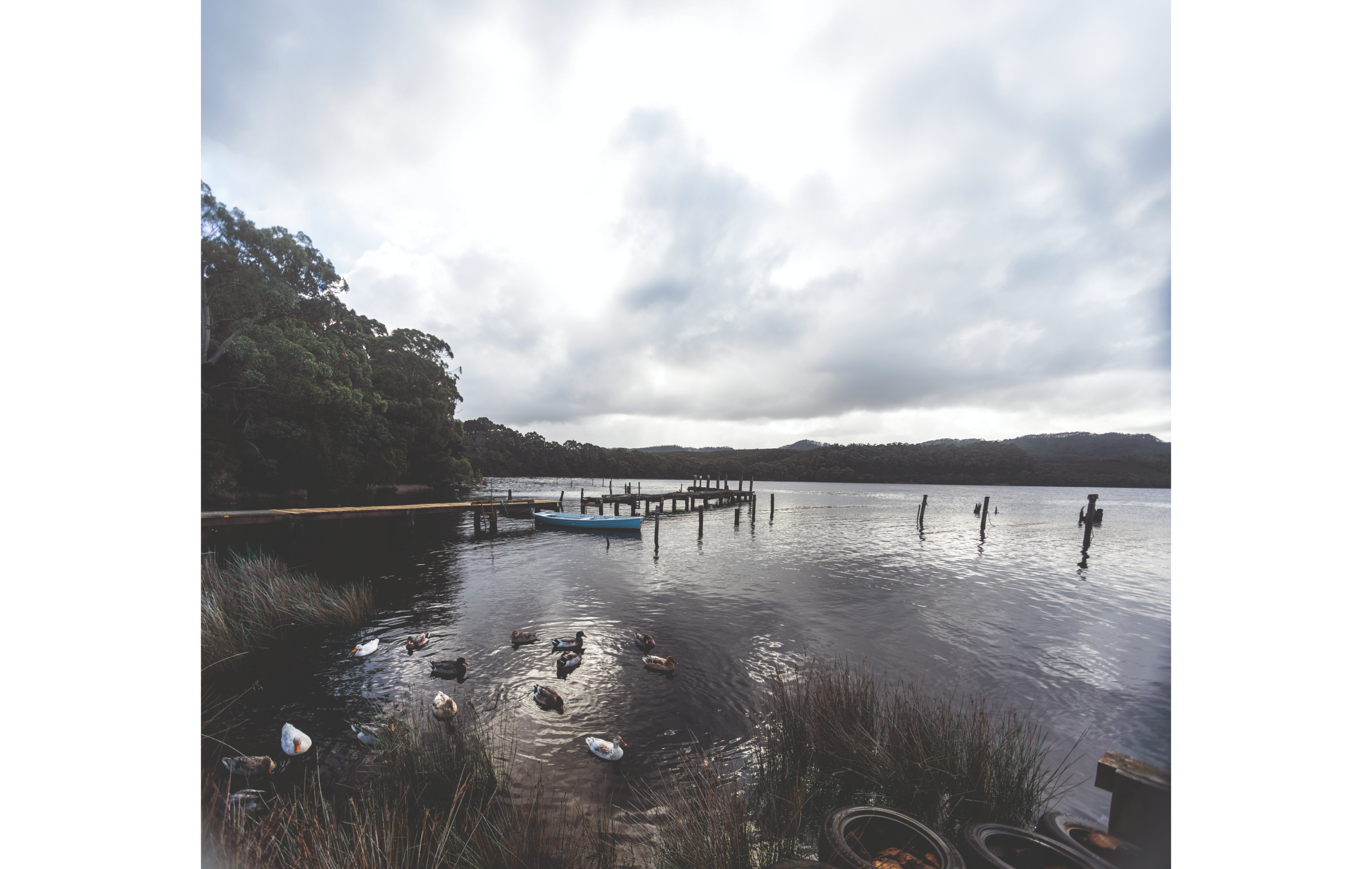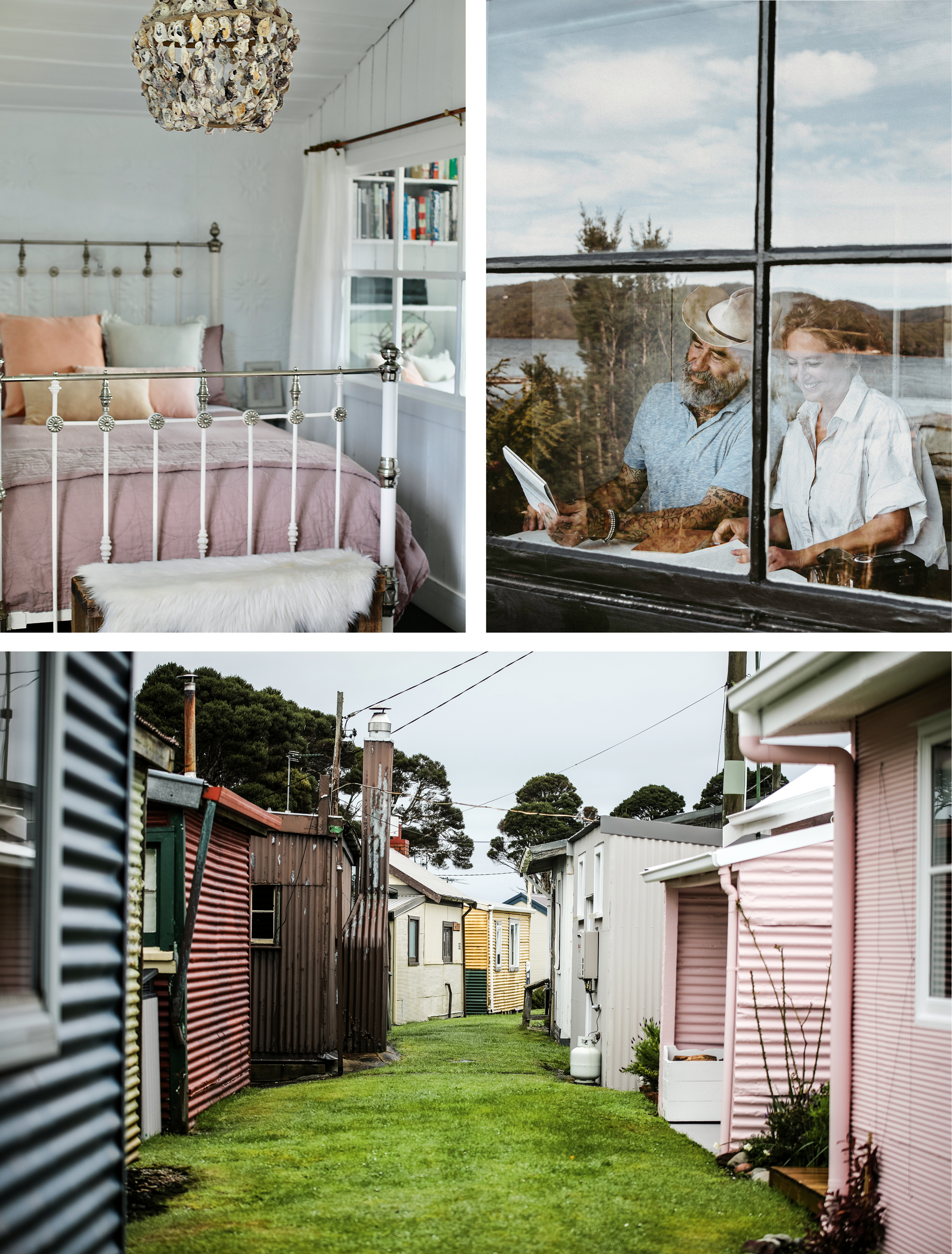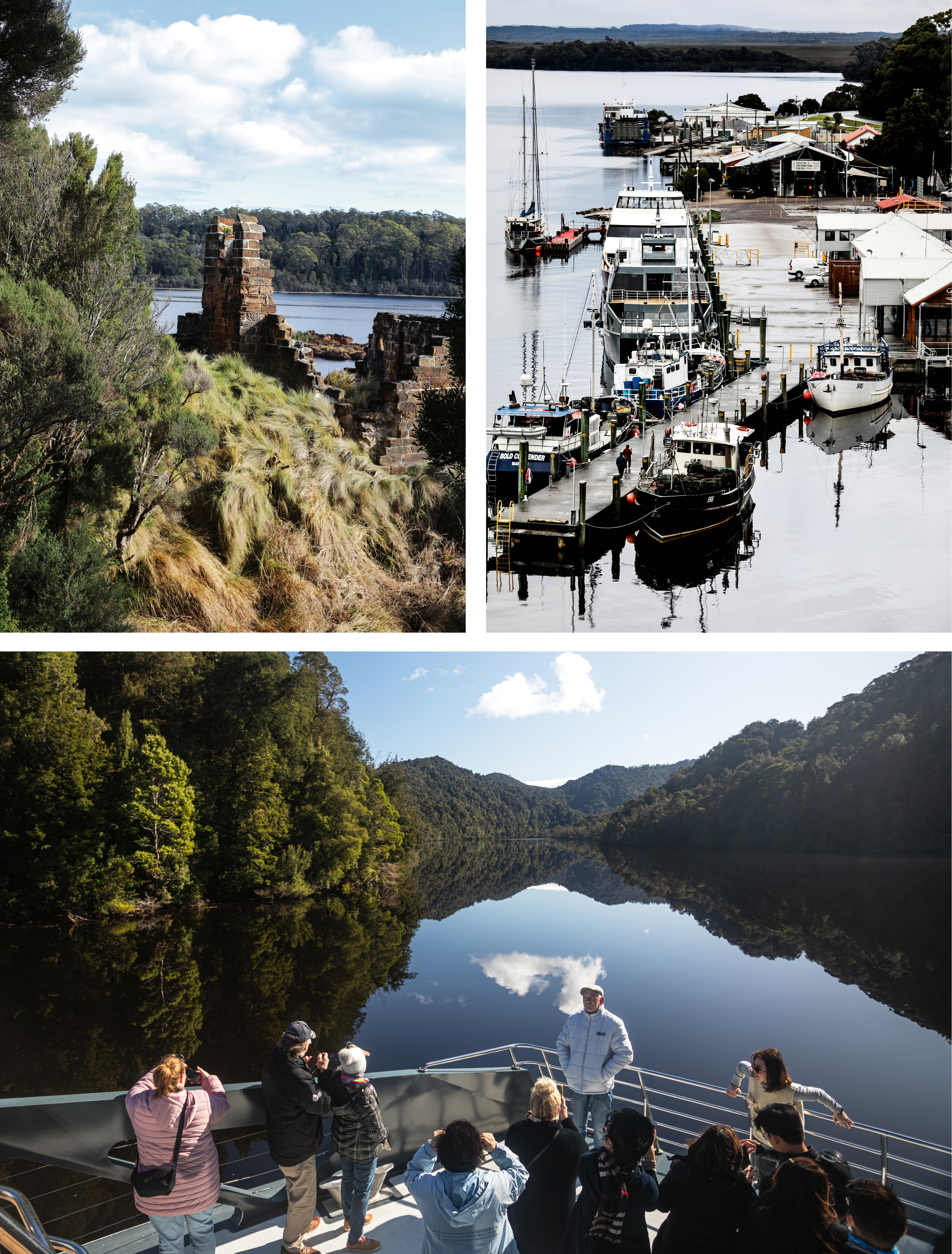
At Lettes Bay, Tas, some comfortable ripple iron and wooden shacks are available to rent.
Shack life
Lettes Bay, on Tasmania’s west coast, has been a popular retreat for locals for more than a century and now woos visitors.
STORY + PHOTOS PAULA HEELAN | OUTBACK MAGAZINE
On a glistening summer day in 2019, artists Claire Lloyd and Matthew Usmar Lauder stood on the water’s edge at Lettes Bay, a historic hamlet on Macquarie Harbour and home to a cluster of about 25 brightly coloured shacks.

The tranquillity of Lettes Bay.
Captivated by the expanse of sweeping, still water flanked by rugged ranges and tangled rainforest, Claire drew breath. “Wow. What do we need to do to buy a place here?” An hour later, after Matthew had wandered around, he told Claire he’d met a local who was selling his shack. “I asked Claire what she thought,” Matthew says. “Unlike me, she’s an impulsive person, so it was an instant ‘yes’.”
This chance meeting led to their purchase of the bay’s most private shack (tucked against a steep precipice and overlooking the bay) and the couple’s renovation adventure in this extraordinary part of Tasmania’s wild west began.
Lettes Bay has a history connected to the Mt Lyell Mining and Railway Company and the nearby harbourside town of Strahan. To provide a hard-earned break from underground working conditions, miners were given a plot of bayside land to build holiday shacks. The first was built around 1890, but most emerged between 1920 and 1950. Unhindered by planning processes, the workers sourced recycled materials from around the district to make comfortable, ripple iron and wooden shacks suited to their needs. Wooden jetties were built in front of the shacks, and fishing, canoeing and swimming became favourite pastimes. While over the decades most of the time-worn shacks have been modified, each still reflects the owners’ commitment to keeping with the original character – imperfections and resourcefulness remain part of the appeal.

CLOCKWISE FROM TOP: Oyster shell light fitting in a bedroom; artists Claire Lloyd and Matthew Usmar Lauder at one of their bayside shacks, Bushy Summers; cluster of brightly coloured, unfenced shacks.
When Claire and Matthew finished restoring their first shack, which they named Bushy Summers, they bought a sister shack and named it Rosy Summers. Both are available to rent via Airbnb or directly via websites.
As chief builder, Matthew took both shacks back to the bones and used clever creativity and keen attention to detail to restore them. With a distinctive flair for the visual, Claire (a designer and photographer) drew on her love of light, space and simplicity. While Bushy has a black and white theme, Rosy is painted in pretty, pale pink on the outside. Bits and pieces throughout the shacks, both new and preloved, plead to be noticed.

CLOCKWISE FROM TOP: Sarah Island – Tasmania’s first penal settlement; Strahan; exploring the World Heritage wilderness on a Gordon River cruise.
By including features from pressed metal walls, interior windows and a seashell chandelier to brass fixtures, Matthew’s inspiring artwork, handmade kitchenware, soft plush linens, a wood fire and a deep, clawfoot bath, the couple has created 2 incredibly comfortable, cosy retreats.
Recently, Tasmanian Petah Long stayed in Bushy. Petah’s father, Paddy, built the original shack with his friend, Bushy, who was the last to live there for a length of time. “When I opened the door and stepped in, I burst into tears,” Petah says. “Childhood memories flooded back. My 2 sisters and I had the most wonderful holidays at the bay. Like us, most of the shack owners were from Queenstown, so we knew everyone. In Dad’s boat (now in the West Coast Heritage Centre at Zeehan), we fished right out through Macquarie Heads, so we always had an abundance of seafood, including crayfish. And we’d take the boat over to the farmhouse across the bay to buy fresh eggs and vegetables. The road down into the bay wasn’t there back then, so supplies and luggage had to be lowered down the steep descent by a cart and pulley.”
While some visitors to Lettes Bay choose to disconnect from all things in order to soak up some quiet, lazy or perhaps creative days, others venture out to discover more of the wilderness area. The historical route to the west coast remains something of a journey: it’s about a 4-hour drive from Launceston, or 5 from Hobart. Winding roads take you through hop-growing country and farmland, where white sheep stand against rich green pasture, past vast freshwater lakes and through dense rainforest.

In 1982, more than 15,000sq km of the surrounding rainforested wilderness was inscribed onto the UNESCO World Heritage List. From the bay, you can explore this wilderness area on a range of guided tours and experiences, whether it be quietly cruising down the magnificent Gordon River, with stops at Heritage Landing rainforest walk and Tasmania’s oldest convict settlement, Sarah Island; hurtling through a gorge on a raft; sailing through the notoriously shallow and treacherous channel entrance known as Hells Gates on Macquarie Harbour; flying above the wilderness by plane or helicopter; bushwalking; or a steam train ride on the West Coast Wilderness Railway, which stretches for more than 30km from Queenstown to Strahan. The green locomotive with shiny red carriages snakes its way through rainforest, high above river valleys and down steep slopes, and in the thick of it, you can’t help wondering about the challenges faced in the 1800s to carve the route through this ancient forest.
Close to Lettes Bay is another popular short walk to Hogarth Falls, where platypus can be spotted. For a wild water experience, Ocean Beach, Tasmania’s longest, starts near Strahan and spans for more than 30km to Trial Bay.
Since the early days of mining and logging (Tasmania’s now protected Huon pine was much sought after for boat-building) those who have grappled with life and living on the west coast have needed to be resilient and resourceful. Each of the nearby towns of Rosebery, Zeehan and Queenstown offer unique experiences and tell of the region’s harsh, pioneering history.
Today, west coast locals continue determinedly to share this rugged, truly beautiful part of the world.